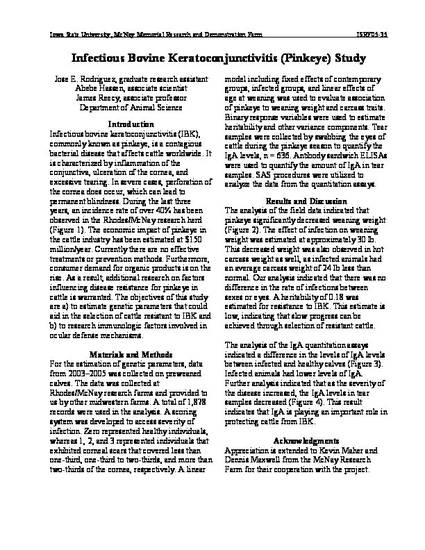
Unpublished Paper
Infectious Bovine Keratoconjunctivitis (Pinkeye) Study
Iowa State Research Farm Progress Reports
Farm
McNay Research and Demonstration Farm
Publication Date
1-1-2006
Disciplines
Abstract
Infectious bovine keratoconjunctivitis (IBK), commonly known as pinkeye, is a contagious bacterial disease that affects cattle worldwide. It is characterized by inflammation of the conjunctiva, ulceration of the cornea, and excessive tearing. In severe cases, perforation of the cornea does occur, which can lead to permanent blindness. During the last three years, an incidence rate of over 40% has been observed in the Rhodes/McNay research herd (Figure 1). The economic impact of pinkeye in the cattle industry has been estimated at $150 million/year.Currently there are no effective treatments or prevention methods. Furthermore, consumer demand for organic products is on the rise. As a result, additional research on factors influencing disease resistance for pinkeye in cattle is warranted. The objectives of this study are a) to estimate genetic parameters that could aid in the selection of cattle resistant to IBK and b) to research immunologic factors involved in ocular defense mechanisms.
Copyright Owner
Iowa State University
Copyright Date
2006
Language
en
File Format
application/pdf
Citation Information
Jose E. Rodriguez, Abebe Hassen and James M. Reecy. "Infectious Bovine Keratoconjunctivitis (Pinkeye) Study" (2006) Available at: http://works.bepress.com/james_reecy/32/
